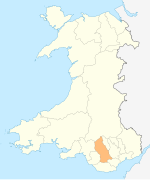River Rhondda
This article needs additional citations for verification. (April 2024) |

The River Rhondda (Welsh: Afon Rhondda) is a river in South Wales with two major tributaries, Rhondda Fawr (meaning big Rhondda) and Rhondda Fach (meaning little Rhondda).
Description

The river has two major
Course
The Rhondda Fawr has its source on the eastern side of
where it joins its sister tributary.The Rhondda Fach rises about a mile to the east of the source of the Rhondda Fawr on the hills above Blaenrhondda in a marshy area between Mynydd Beili Glas and Mynydd Bwllfa at an elevation of 489m OD. at Porth.
The River Rhondda flows on past Trehafod to reach its confluence with the River Taff at Pontypridd.
Improving water quality
The mining industry had a catastrophic impact on the quality of the river with all the mine waters being pumped straight into the river with no treatment. For very long periods, probably more than a century, the river was continuously black with coal solids and little if anything could live in the river. This was compounded by the very basic sewage disposal arrangements which saw all the sewage discharged into the same river. Not until the 1970s was there real investment made in improving the sewage treatment arrangements.
Since the early 1970s the river has been steadily improving in quality largely due to the closure of all the coal mines and through the investment in sewerage and sewage treatment.
Bibliography
- Lewis, E.D. (1959). The Rhondda Valleys. London: Phoenix House.

